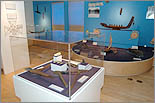 |
|
February 18, 2005 :: No. 132 Seven anthropology students have delved into two new worlds: that of museum curation and of early Oceanic explorers. The resulting Anthropology Museum exhibit, “Conquest of the Pacific: Society on the Sea,” showcases the exploration and settlement of the Pacific islands through tools, models and other items. “What were the migration patterns these people followed and how did they get there? Those were the questions we were seeking to answer,” said senior anthropology major Eric Paison. “We were only able to scratch the surface of this amazing period.” The students worked under the direction of Armand Labbe, chief curator and director of research and collections at the Bowers Museum, who teaches the upper-division curation and exhibit-design course. The student curators are: Candice Alvarado, Kimberly Casey, Paul Constantine, Cat Elrod, Noreen Javadi, Paison and Justin Stewart. “Like the Pacific navigators portrayed in this exhibit, student curators who take on these museum projects embark on a voyage of discovery that tests their capacity for creativity, perseverance and ability to work together toward a common goal,” said Susan Parman, chair and professor of anthropology and museum director. “Their guide to self-discovery has been Armand Labbe, who has shared his expertise in teaching the department’s museum classes, and in challenging students to explore multiple visions of what it means to be human.” The exhibit, which includes items on loan from the Newport Harbor Nautical and Bowers museums, evolved while the students attended two classes. The first, held in spring 2004, focused on how to curate an exhibit, plus the history behind the people and their migration. The second course, held last fall, involved the implementation of what they had learned: selecting the pieces, designing the placement of the items, and creating and posting the identifying labels. To complete the tasks, the student team worked during Intersession, and the finishing touches were made just before the exhibit opened Feb. 28. The project was intense and challenging, especially in maintaining valuable communication throughout the process, said the students. “We had such different schedules with our classes and work. We often had to work independently,” said Candice Alvarado. “It was very hard sometimes to get certain things done in a timely manner. But it was an amazing feeling to see the exhibit come together.” “It was very time-consuming...more time consuming than we thought it would be,” said Kimberly Casey, a senior. “It was a hard process to go through but it was very rewarding to see it all come together. Seeing it get to this point was the best feeling ever.” “We made numerous mistakes along the way,” said Paul Constantine. “But that’s what this class was all about. We were allowed to make mistakes, put in situations we thought we might not be able to overcome and forced to work out problems within the group. “We are proud of the work we have done, and we do know that if we ever are in the position to do this again, we have acquired the skills that will make the next project a success,” Constantine added. Among the items on exhibit are stick charts used by the Oceanic peoples for navigation. The primitive maps were used to identify where islands were located and the currents that they would face at different times of the year. “They were very accurate and reflected a vast knowledge of the sea,” said Casey. Also exhibited are canoe models, paddles, prow pieces, tools used to create canoes and trade goods. The exhibit continues through May 31 and is open Mondays through Fridays from 9 a.m. to 5 p.m. in Room 424 of McCarthy Hall.
|
|
